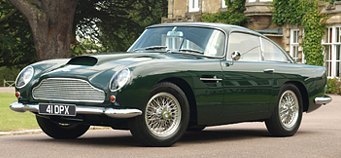
| Mercedes-Benz - 12% |
| Geely - 17% |
| - |
Note: Rapide is assembled by Magna Steyr at Graz, Austria.

2021 sales: 6,182 units (including 3,001 DBX)
2020 sales: 3.394 cars
2019 sales: 5,862 cars
2018 sales: 6,441 cars
2017 sales: 5,098 cars
2016 sales: 3,687 cars
2015 sales: 3,615 cars
2014 sales: 3,661 cars
2013 sales: 4,200 cars (approx.)
2012 sales: 3,500 cars (approx.)
2011 sales: 4,200 cars (approx.)
2010 sales: 5,000 cars (approx.)
2009 sales: 3,875 cars
2008 sales: 5,800 cars
2007 sales: 6,850 cars
2006 sales: 6,500 cars
2005 sales: 4,400 cars
2004 sales: 2,400 cars
2003 sales: 1,514 cars
Today, Aston is no longer a subsidiary of Ford. Without the protection of a strong parent, its future could be more bumpy.
However, the tiny sports cars specialist remained little known to the world as it lacked any great creations. Its ownership changed hands frequently until David Brown bought it in 1947, then it enjoyed 25 years of financial stability. Brown introduced the DB series (short write of his name) starting from DB2 in 1950. It introduced a twin-cam straight-six engine to provide the necessary performance to rival others. However, what really made Aston famous was the 3.6-liter DB4, especially its short-wheelbase version DB4GT and lightweight Zagato version. They gave the contemporary Ferrari 250GTO a strong challenge in motor racing while winning sales with its elegant style and good performance.
 1959 DB4 GT
1959 DB4 GTThe DB series continued to prosper with DB5, which was featured in James Bond's movie "The Gold Finger". This car became a luxury grand tourer and gave Aston a reputation as the finest British luxury performance car.
In 1950s and 60s, Aston was active in motor racing. Its DBR1/300 won the World Sports Car Championship in 1959. DB2 won a class victory in Le Mans. The DB4GT Zagato was also highly competitive in GT racing. However, the lack of funding and development prevent Aston from greater success.
During the golden years under David Brown, Aston acquired luxury car marque Lagonda and coahbuilder Tickford. When the V8-engined DBS was launched in 1969, Aston Martin was still one of the most admired sports car specialists in the world. People usually compared it with Ferrari and Maserati. Through the 70s, more changes of its ownership resulted in the lack of research and development. AM became increasingly reliance on its traditional style, craftsmanship and luxury to keep the old customers delighted. It was regarded as another Bentley, just faster and rarer.
Aston amazed the world in 1978 with the radically styled Lagonda luxury saloon, but the financial instability, hence underdevelopment and varying quality, meant it could hardly rival the performance Bentley turbo and Mercedes. Another surprise was presented by the 1986 Zagato, a limited edition supercar designed and built by Italian coachbuilder Zagato. With a top speed of 186 mph, it was once the fastest car in the world.
 1993 DB7
1993 DB7However, these cars did not change the fundamental financial troubles of the company. A breakthrough was made in 1987 when Ford bought 75% shares of Aston Martin. It funded the development of an all-new entry-level car, DB7. As Aston no longer had the R&D experts as it was in the 50s and 60s, the development work of DB7 was assigned to Tom Walkinshaw's TWR. Production also took place in the Bloxham factory of TWR (which would be bought by Ford later on), while the old Newport Pagnell factory continued building the low-volume V8 Virage / Vantage. The DB7 was proved to be a turning point of Aston's fate. Around 7,000 cars were sold in the next 11 years.
Thanks to the success of DB7, Ford got serious with Aston Martin since the new millenium. It set a plan to build 8,000 Aston Martins a year. It hired ex-Porsche engineer Ulrich Bez to manage the company, poured substantial money to build the modern factory and R&D facilities at Gaydon. 3 model lines (V8 Vantage, DB9 and Vanquish) were set to build on a sophisticated aluminum spaceframe platform dubbed VH. The investment paid off quickly. Aston sold 7,300 cars in 2007 and successfully rebuilt its image as a prestige sports car brand.
The improved prospect allowed Ford to sell Aston in 2008 for £475 million to a consortium of investors including David Richard (boss of Prodrive), John Sinders (an Aston collector) and two Kuwaiti investment firms. Ford needed those cash desperately to cover its own loss.